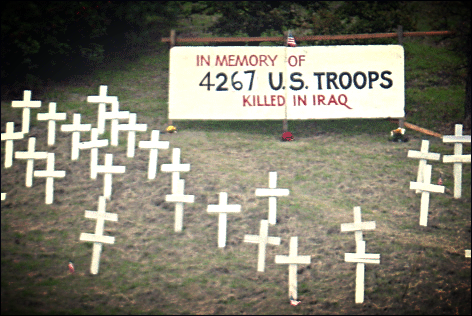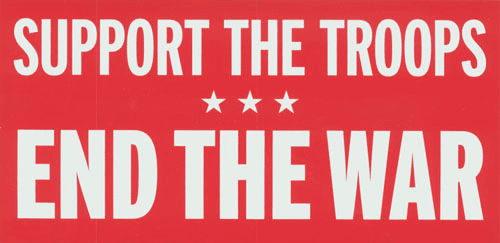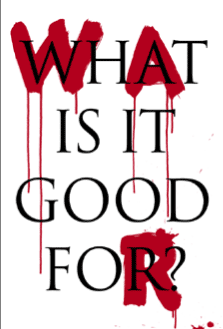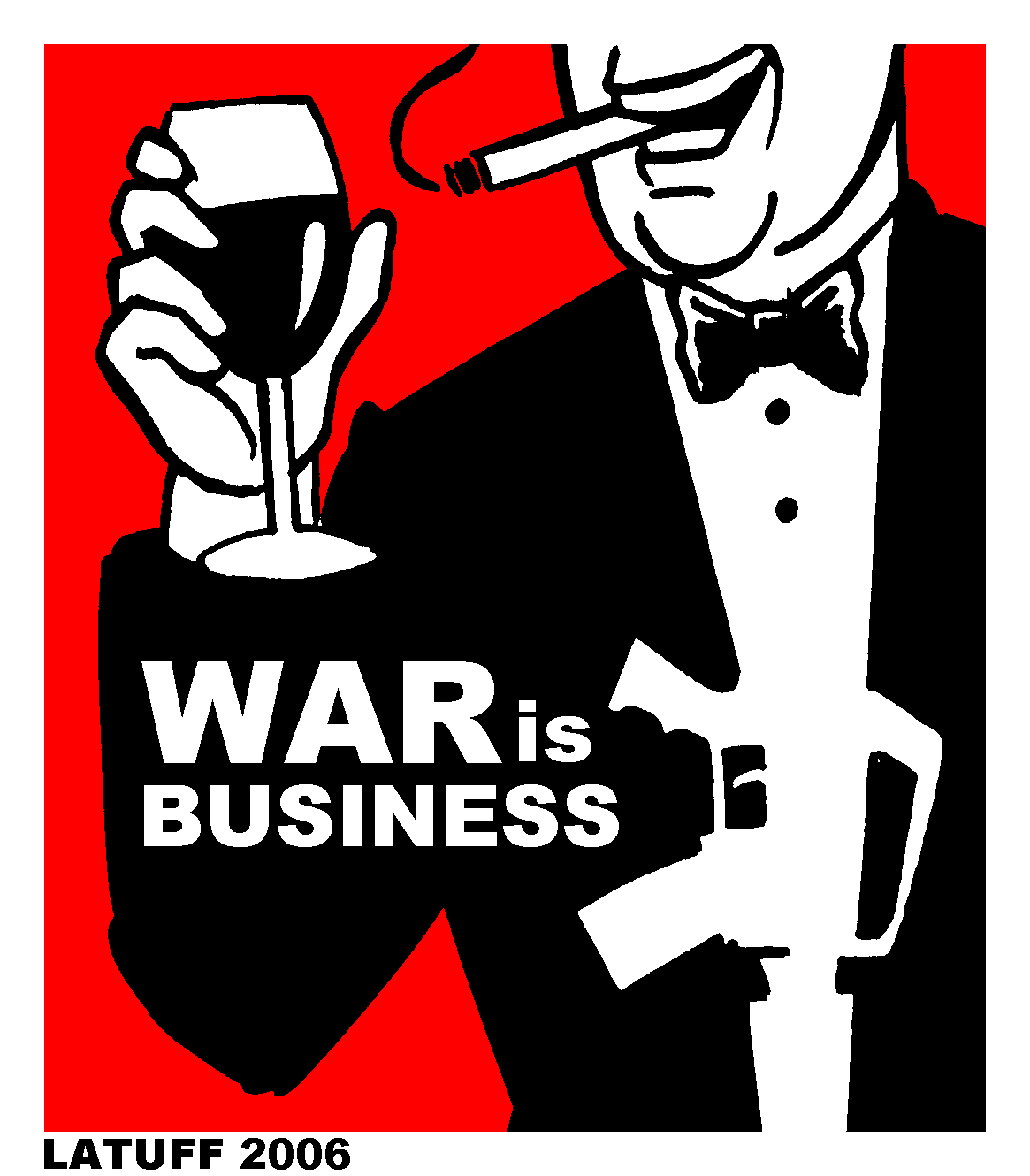Edwin Starr - War
(What Is It Good For?)
An anti war movement (also antiwar) is a social movement, usually
in opposition to a particular nation's decision to start or carry on an
armed conflict, unconditional of a maybe existing just cause. The
term can also refer to pacifism , which is the opposition to all use
of military force during conflicts. Many activists distinguish between
anti war movements and peace movements. Anti war activists work
through protest and other grassroots means to attempt to pressure
a government (or governments) to put an end to a particular war or
conflict.
Many groups call themselves anti war activists though their
opinions may differ:
some anti war activists may be equally opposed
to both sides' military campaign; in contrast, many modern activists
are against only one side's campaigns (usually the one they see as
most unethical).
Pacifist and anti war movements are similar, but not the same.
Pacifism is the belief that violent conflict is never acceptable and
that society should not be ready to fight in aconflict:
the anti war
movement is not necessarily opposed to national defence .
Pacifists oppose all war, but anti-war activists may be opposed to
only a particular war or wars. The historic peace churches such as
the Brethren, the Mennonites and the Quakers teach that Jesus advocates non violence, and
that his followers must do likewise.
Substantial anti war sentiment developed in America during the period roughly falling between the
end of the War of 1812 and the commencement of the Civil War, or what is called the antebellum
era. (A similar movement developed in England). The movement reflected both strict pacifist and
more moderate non interventionist positions. Many prominent intellectuals of the time, including
Ralph Waldo Emerson, Henry David Thoreau and William Ellery Channing contributed literary
works against war. Other names associated with the movement include William Ladd, Noah
Worcester, Thomas Cogswell Upham and Asa Mahan. Many peace societies were formed
throughout the United States, the most prominent of which being the American Peace Society.
Numerous periodicals (e.g., The Advocate of Peace) and books were also produced. The Book of
Peace, an anthology produced by the American Peace Society in 1845, must surely rank as one
of the most remarkable works of anti war literature ever produced.
A recurring theme in this movement was the call for the establishment of an international court
which would adjudicate disputes between nations. Another distinct feature of antebellum anti war
literature was the emphasis on how war contributed to a moral decline and brutalisation of society
in general.
A key event in the early history of the modern anti-war stance in literature and society was the
American Civil War, where it culminated in the candidacy of George McClellan for President of the
United States as a "Peace Democrat" against incumbent President Abraham Lincoln. The outlines
of the anti war stance are seen:
the argument that the costs of maintaining the present conflict are
not worth the gains which can be made, the appeal to end the horrors of war, and the argument
that war is being waged for the profit of particular interests. During the war, the New York Draft
Riots were started as violent protests against Abraham Lincoln's Enrollment Act of Conscription
plan to draft men to fight in the war. The outrage over conscription was augmented by the ability
to "buy" your way out; the amount of which could only be afforded by the wealthy. After the war,
The Red Badge of Courage described the chaos and sense of death which resulted from the
changing style of combat:
away from the set engagement, and towards two armies engaging in
continuous battle over a wide area.
"TITTER YE NOT"
****************** LETTER HOME...
A young soldier left home to join the army.
He told his girl friend that he would write every day.
After about six months,
he received a letter from his girlfriend saying that she was marrying
someone else.
He wrote home to his
family to find out who she married.
The family wrote back and told him.
It was the mailman.
******************
A journalist had done a
story on gender roles in Kuwait several years
before the Gulf War, and she noted then that
women customarily
walked about 10 feet
behind their husbands.
She returned to Kuwait recently and observed that the men now walked several yards behind their wives.
She approached one of
the women for an explanation.
"This is marvellous," said the journalist.
"What enabled women here to achieve this reversal of roles?"
The Kuwaiti woman
replied:
"Land mines"
******************
War Is A Dick Thing,
Peace Is A Heart Thing.
*******************




In Britain, in 1914, the Public Schools Officers' Training Corps annual camp was held at Tidworth
Pennings, near Salisbury Plain. Head of the British Army Lord Kitchener was to review the
cadets, but with war looming it prevented him from doing this. General Horace Smith Dorrien
was sent instead. He surprised the two or three thousand cadets by declaring (in the words of
Donald Christopher Smith a Bermudian cadet who was present) that war should beavoided at
almost any cost, that war would solve nothing, that the whole of Europe and more besides would
be reduced to ruin, and that the loss of life would be so large that whole populations would
decimated.
In our ignorance I, and many of us, felt almost ashamed of a British General who uttered such
depressing and unpatriotic sentiments, but during the next four years, those of us who survived
the holocaust probably not more than one quarter of us learned how right the General's prognosis was and how courageous he had been to utter it. Having voiced these sentiments did not hinder Smith Dorrien's career, or prevent him from carrying out his duty in the First World War to the best of his abilities. With the increasing mechanisation of war, opposition to its horrors grew, particularly in the wake of the First World War. European avant garde cultural movements such as Dada were explicitly anti war.
The Espionage Act of 1917 and the Sedition Act of 1918 gave the Americans the right to close newspapers and jailed individuals for having anti-war views. On June the 16th, 1918, Eugene V. Debs made an anti-war speech and was arrested under the Espionage Act of 1917. He was convicted, sentenced to serve
ten years in prison, but President Warren G. Harding commuted his sentence on December the 25th, 1921.
In 1924 Ernst Friedrich published Krieg dem Kriege! (War Against War!) an album of photographs drawn from German military and medical archives from the first world war. In On the pain of others Sontag describes the book as 'photography as shock therapy' that was designed to 'horrify and demoralise'.
It was in the 1930s that the Western anti war movement took shape, to which the political and organisational roots of most of the existing movement can be traced. Characteristics of the anti war movement included opposition to the corporate interests perceived as benefiting from war, to the status quo which was trading the lives ( cannon fodder ) of the young for the comforts of those who are older, the concept that those who were drafted were from poor families and would be fighting a war in place of privileged individuals who were able to avoid the draft and military service, and to the lack of input in decision making that those who would die in the conflict would have in deciding to engage in it.
In 1933, the Oxford Union resolved in its Oxford Pledge, "That this House will in no circumstances fight for its King and Country."
Many war veterans, including US General Smedley Butler, spoke out against wars and war profiteering on their return to civilian life.
Veterans were still extremely cynical about the motivations for entering WWI, but many were willing to fight later in the Spanish Civil War, indicating that pacifism was not always the motivation. These trends were depicted in novels such as All Quiet on the Western Front For Whom the Bell Tolls and Johnny Got His Gun.
“Those who do not learn
from history are doomed
to repeat it”
Opposition to World War II was most vocal during its early period, and stronger still before it
started while appeasement and isolationism were considered viable diplomatic options.
Communist led organizations, including veterans of the Spanish Civil War, opposed the war
during the period of the Hitler and Stalin pact but then turned into hawks after Germany
invaded the Soviet Union.
The war seemed, for a time, to set anti war movements at a distinct social disadvantage; very
few, mostly ardent pacifists, continued to argue against the war and its results at the time.
However, the Cold War followed with the post war realignment, and the opposition resumed.
The grim realities of modern combat, and the nature of mechanized society ensured that the
anti war viewpoint found presentation in Catch 22 Slaughterhouse Five and The Tin Drum.
This sentiment grew in strength as the Cold War seemed to present the situation of an
unending series of conflicts, which were fought at terrible cost to the younger generations.
Opposition to U.S. involvement in the Vietnam War began slowly and in small numbers in 1964
on various college campuses in the United States and grew into very large demonstrations
from 1967 until 1971. Counter cultural songs, organizations, plays and other literary works
encouraged a spirit of nonconformism, peace, and anti establishment arianism.
This anti war sentiment developed during a time of unprecedented student activism and just
after the main events of America's Civil Rights Movement and was reinforced in numbers by
the demographically significant baby boomers. It quickly grew to include a wide and varied
cross section of Americans from all walks of life. The anti Vietnam war movement is often
considered to have been a major factor affecting America's involvement in the war itself. Many
Vietnam veterans, including the late Secretary of State and former U.S. Senator John Kerry and disabled veteran Ron Kovic, spoke out against the Vietnam War on their return to the United States.
There was initially little opposition to the 2001 Afghanistan War in the United States and the United Kingdom, which was seen as a response to the September 11th, 2001, terrorist attacks and was supported by a majority of the American public. Most vocal opposition came from pacifist groups and groups promoting a leftist political agenda; in the United States, the group A.N.S.W.E.R. was one of the most visible organisers of anti war protests, although that group faced considerable controversy over allegations it was a front for the extremist Stalinist Workers World Party. Over time, opposition to the war in Afghanistan has grown more widespread, partly as a result of weariness with the length of the conflict, and partly as a result of a conflating of the conflict with the unpopular war in Iraq.
The anti war position gained renewed support and attention in the build up to the 2003 invasion of Iraq by the U.S. and its allies. Millions of people staged mass protests across the world in the immediate prelude to the invasion, and demonstrations and other forms of anti war activism have continued throughout the occupation. The primary opposition within the U.S. to the continued occupation of Iraq has come from the grassroots. Opposition to the conflict, how it had been fought, and complications during the aftermath period divided public sentiment in the U.S., resulting in majority public opinion turning against the war for the first time in the spring of 2004, a turn which has held since. Anti war groups protested during the both the Democratic National Convention and 2008 Republican National Convention protests held in St. Paul, Minnesota in September 2008.
WAR INNOCENTS SUFFER
Organised opposition to a possible future military attack against Iran by the United States is known to have started during 2005 2006. Beginning in early 2005, journalists, activists and academics such as Seymour Hersh, Scott Ritter, Joseph Cirincione and JorgeE.
Hirsch began publishing claims that United States' concerns over the alleged threat posed by the possibility that Iran may have a nuclear weapons program might lead the US government to take military action agains that country in the future. These reports, and the concurrent escalation of tensions between Iran and some Western vernments, prompted the formation of grass roots organisations, including Campaign Against Sanctions and Military Intervention in Iran in the US and the United Kingdom, to advocate against potential military strikes on Iran.
Additionally, several individuals, grassroots organisations and international governmental organisations, including the Director General of the International Atomic Energy Agency,
Mohamed El Baradei , a former United Nations weapons inspector in Iraq, Scott Ritter, Nobel Prize winners including Shirin Ebadi, Mairead Corrigan Maguire and Betty Wil Pinter and Jody Williams, Campaign for Nuclear Disarmament Movement of 118 states, and the Arab League, have publicly stated their opposition to a would be attack on Iran.
Anti war Putin demonstrations took place in Moscow "opposing the War in Donbass", i.e., in the Eastern Ukraine, But 40,000 attend Moscow pro Putin rally "...The demonstrators, some dressed in fatigues, waved Russian flags and many sported the black and orange St George ribbon, a symbol of victory over Nazi Germany that pro Russian Ukrainian separatists have adopted as their badge of honour..." Yahoo News, February the 21st, 2015.
English poet Robert Southey's 1796 poem After Blenheim is an early modern
example of anti-war literature — it was written generations after the Battle of
Blenheim, but at a time when England was again at war with France.
World War I produced a generation of poets and writers influenced by their
experiences in the war. The work of poets including Wilfred Owen and
Siegfried Sassoon exposed the contrast between the realities of life in the
trenches and how the war was seen by the British public at the time, as well as
the earlier patriotic verse penned by Rupert Brooke. German writer Erich Maria
Remarque penned All Quiet on the Western Front, which, having been adapted
for several mediums, has become the most often cited pieces of anti war media.
BLACK SABBATH
WAR PIGS
Pablo Picasso's 1937 painting Guernica , on the other hand, used abstraction
ratherduringthe Spanish Civil War. American author Kurt Vonnegut used science
fiction themes in his 1969 novel Slaughterhouse Five, depicting the bombing of
Dresden in World War II (which Vonnegut witnessed).
The second half of the 20th century also witneastrong anti war presence in other art forms, including anti war music such as " Eve of Destruction " and One Tin Soldier and films such as M*A*S*H and "Die Brücke", opposing the Cold War in general, or specific conflicts such as the Vietnam War. The American war in Iraq has also generated significant artistic anti war works,
including film maker Michael Moore's Fahrenheit 9/11, which holds the box office record for documentary films, and Canadian musician Neil Young's 2006 album Living with War.
While pacifism is opposition to all war, anti militarists, while rejecting military values, do not reject war in all circumstances. Pacifism has been historically associated with faith in transcendent ideas, such as "God" or "Humanity", which Stirner, for example, criticized in The Ego and Its Own (1844), a milestone of individualist anarchism.
Pacifism is thus opposed to atheistic anti militarism, which is based on a critical analysis of the military state institution, the military industrial complex and, in a broader sense, patriotism and the nationalist concept of nation states' sovereignty. Thus, Gandhi justified non violence by an ideal of redemption with the idea that non-violence makes one morally stronger, while the early Martin Luther King based his civil disobedience techniques on his Christian faith (later his criticism of the Vietnam War was quite secular). On the contrary, anti militarism was commonly found alongside anti-clericalism since the Church and the Army represented repressive institutions (or Ideological State Apparatuses ISA as Marxist philosopher Louis Alt husser called them).
Anti militarism, as a specific doctrine distinguished from pacifism, is not opposed to violence in general, but mainly to the state's control of police forces and the military institution. Anti militarism is thus often a logical consequence of anti statism, and vice versa. Finally, anti militarism should not be confused either with the Clausewitzian doctrine of civilian control of the military, which considers that "war is the continuation of politics by other means" and that tactics and strategy must thus be controlled by diplomacy and political objectives. Although Clausewitz opposed Jomini's advocacy of the autonomy of the military institution, which became a reality with Prussian militarism and the Schlieffen Plan , the latter limiting the political choices available until war finally became the only solution available (and thus exploded in World War I), his doctrine of limitation of military power was clearly an effort to increase the power of the state, rather than to oppose interstate wars.



In order to facilitate organized, determined, and principled opposition to war, peace centered activists have often founded anti war organizations . These groups range from temporary coalitions which address one war or pending war, to more permanent structured organizations which work to end the concept of war and the factors which lead to large scale destructive conflicts. The overwhelming
majority do so in a non violent manner.
The Society for the Promotion of Permanent
and Universal Peace was founded on the 14th of June 1816. It advocated a gradual,
proportionate, and simultaneous disarmament of all nations and the principle of
arbitration. The Society in London established Auxiliary Societies in various cities and
towns in the United Kingdom:
for instance at Doncaster and Leeds.
Lewis Appleton organized the International Arbitration and Peace Association (IAPA) in
1880. Unlike the Peace Society the IAPA accepted defensive war, was not restricted to
Christians and claimed to be international. It also allowed women on the executive
committee. In the spring of 1882 E.M. Southey, the main founder of the Ladies Peace
Association, persuaded her group to disaffiliate from the Peace Society and move to the
IAPA. The Quaker Priscilla Hannah Peckover played a central role in organizing a new
ladies auxiliary of the Peace Society that was launched on the 12th of July 1882. During
the 1880s the Peace Society stagnated. Its Ladies' Peace Association was much more
dynamic, and claimed 9,217 members by the summer of 1885, of which 4,000 belonged
to Peckover's Wisbech group. The Society's failure to condemn the outbreak of World
War I in 1914 resulted in internal divisions and led to the resignation of its leader William
Evans Derby. His successor, Reverend Herbert Dunnico, led the society's unsuccessful
campaign for peace negotiations.
In 1930 the Peace Society merged with the International Christian Peace Fellowship and
was renamed the International Peace Society. At some time thereafter it became defunct.
It published a monthly journal, The Herald of Peace , founded in 1819.
Older men declare war. But it is the youth that must fight and die.
- Herbert Hoover
Born: August 10, 1874, Died:
October 20, 1964
The material on this site does not necessarily reflect the views of What If? Tees.
The Images and Text are not meant to offend but to Promote Positive Open Debate and Free Speech.
The material on this site does not reflect the views of What If? Tees.
The Images and Text are not meant to offend but to Promote Positive Open Debate and Free Speech.




































